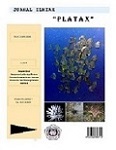Molecular Identification And Conservation Status Of Sharks From The Fins Trade In Manado City North Sulawesi
DOI:
https://doi.org/10.35800/jip.v9i2.36016Keywords:
Molekuler, COI, hiu, IUCN Red list .Abstract
Sharks are a group of cartilaginous fish that are vulnerable to overfishing. Genetics approaches play an important role in shark conservation. Shark fishing has become the main activity of fishermen in several areas, including in North Sulawesi. This research is focused on the molecular aspects and conservation status of shark species obtained from the shark fin trade in Manado, North Sulawesi. COI gene was amplified using Fish BCL5 (for) and HCO219 (rev) primers. Nucleotide sequences of each sample were aligned with the closest sequences in the GenBank database using the BLAST (Basic Local Alignment and Search Tool) method. The conservation status of the shark species is carried through the IUCN (International Union for the conservation of nature red list) Red list website. Molecular identification results showed that the shark’s fins from Manado had high similarity with Carcharhinus falciformis (HM1 and HM2) and Carcharhinus melanopterus (HM3). According to IUCN red list data, the C. falciformis and C. melanopterus were categorized as vulnerable to extinction (VU).
Keywords:Â Molekuler; COI; Shark; Manado and IUCN Red list .
Â
Abstrak
Hiu merupakan kelompok ikan bertulang rawan yang sangat rentan terhadap dampak penangkapan secara berlebihan. Informasi terkait genetik hiu yang semakin terancam populasinya sangat berperan penting dalam upaya konservasi hiu. Penangkapan hiu telah menjadi aktivitas utama nelayan di beberapa daerah, termasuk di Sulawesi Utara. Penelitian ini difokuskan pada aspek  molekuler dan penentuan status konservasi spesies hiu menggunakan sampel sirip yang di dapatkan dari perdagangan sirip hiu, di kota Manado. Amplifikasi gen COI dilakukan dengan menggunakan primer Fish BCL5 (for) dan HCO219 (rev). Sekuens nukleotida masing-masing sampel disejajarkan dengan nukleotida terdekat yang ada dalam database genbank menggunakan metode BLAST (Basic Local Aligment and Search Tool) Penentuan status konservasi dilakukan melalui penelusuran spesies rujukan di situs IUCN (International Union for the Conservation of Nature) Red list. Hasil identifikasi molekuler menunjukan bahwa sampel sirip hiu dari  kota Manado  memiliki kemiripan yang tinggi dengan spesies : Carcharhinus falciformis  (HM1 dan HM2) dan C. melanopterus (HM3).  Menurut data IUCN Red list, C. falciformis dan C. Melanopterus merupakan jenis hiu dalam status konservasi rentan punah (VU).Â
Kata Kunci: Molekuler; COI; hiu; Manado dan IUCN Red list
References
Alberts, B., A. Johnson, J. Lewis, M. Raff, K. Roberts & Walter. P. 2008. Molecular biology of the cell (5th edition). Garland Science. New York.
Ardani, B. N. & Yusuf, S., 2007. ‘Aspek Biologi beberapa jenis ikan hiu dan pari (elasmobranchini) di pesisir Kota Waringin Barat’ Journal of Tropical Fisheres, 2(2): 35-44.
Aires-da-Silva, A., Lennert-Cody, C., Maunder, M.N. and Román-Verdesoto, M. 2014. Stock status indicators for silky sharks in the eastern Pacific Ocean. Document SAC-05-11a. Inter-American Tropical Tuna Commission Scientific Advisory Committee Fifth Meeting. 12-16 May 2014, La Jolla, California, USA [http://www.iattc.org/Meetings/Meetings2014/MAYSAC/PDFs/SAC-05-11a-Indicators-for-silky-sharks.pdf].
Arauz, R.M., Cohen, Y., Ballestero, J., Bolaños, A. and Pérez, M. 2004. Decline of shark populations in the Exclusive Economic Zone of Costa Rica. Proceedings of the International Symposium on Quantitative Ecosystem Indicators for Fisheries Management. Paris, France.
Bonfil, R. (2008). The biology and ecology of the silky shark, Carcharhinus falciformis. Sharks of the open ocean: biology, fisheries and conservation, 114-127.
Chari, N. A., & Lestari, N. D. (2019). SILKY SHARK TRUST: STRATEGI PENGELOLAAN KONSERVASI HIU KEJEN (Carcharhinus falciformis) DI PPP MUNCAR, BANYUWANGI. PROSIDING PUSAT RISET PERIKANAN, 1(1), 293-300.
Chin, A., Simpfendorfer, C., Tobin, A., & Heupel, M. (2013). Validated age, growth and reproductive biology of Carcharhinus melanopterus, a widely distributed and exploited reef shark. Marine and Freshwater Research, 64(10), 965-975.
Chodrijah, U., Jatmiko, I., & Sentosa, A. A. (2018). Parameter Populasi Hiu Kejen (Carcharhinus falciformis) di Perairan Selatan Nusa Tenggara Barat. BAWAL Widya Riset Perikanan Tangkap, 9(3), 175-183.
Clarke, C.R., Karl, S.A., Horn, R.L., Bernard, A.M., Lea, J.S., Hazin, F.H., Prodohl, P.A. and Shivji, M.S. 2015. Global mitochondrial DNA phylogeography and population structure of the silky shark, Carcharhinus falciformis. Marine Biology 162(5): 945-955.
Compagno, L.J.V. and V.H. Niem, 1998. Carcharhinidae. Requiem sharks. p. 1312-1360. In K.E. Carpenter and V.H. Niem (eds.) FAO Identification Guide for Fishery Purposes. The Living Marine Resources of the Western Central Pacific. FAO, Rome.
Corkill, G. & Rapley, R. 2008. The Manipulation of Nucleic Acids: Basic Tools and Techniques. Molecular Biomethods Handbook. 3-15
Dharmadi, D., Fahmi, F., & Adrim, M. (2017). Distribusi frekuensi panjang, hubungan panjang tubuh, panjang klasper, dan nisbah kelamin cucut lanjaman (Carcharhinus falciformis). Jurnal Penelitian Perikanan Indonesia, 13(3), 243-254.
Fahmi dan Dharmadi (2013a). Pengenalan jenis-jenis hiu Indonesia. Direktorat Konservasi Kawasan dan Jenis Ikan, Kementerian Kelautan dan Perikanan, Jakarta; 63 pp.
Fahmi dan Dharmadi (2013b). Tinjauan status perikanan hiu dan upaya konservasinya di Indonesia. Direktorat Konservasi Kawasan dan Jenis Ikan, Kementerian Kelautan dan Perikanan, Jakarta; 179 pp.
Fahmi and Dharmadi (2015). Pelagic shark fisheries of Indonesia’s eastern Indian Ocean fisheries management region. African journal of marine science. 37(2), 259-265.
FAO. 2015. Species fact sheets: Carcharhinus falciformis. Available at: www.fao.org/fishery/species/2021/en.
Galván-Tirado, C., Galvan-Magaña, F., & Ochoa-Báez, R. I. (2015). Reproductive biology of the silky shark Carcharhinus falciformis in the southern Mexican Pacific. Journal of the Marine Biological Association of the United Kingdom, 95(3), 561-567.
Grant, M. I., Smart, J. J., White, W. T., Chin, A., Baje, L., & Simpfendorfer, C. A. (2018). Life history characteristics of the silky shark Carcharhinus falciformis from the central west Pacific. Marine and Freshwater Research, 69(4), 562-573.
Griffin, E., K.L. Miller, B. Freitas, M. & Hirsfield, 2008. Predators as prey: Why healthy oceans need sharks. Oceana. Washington DC.
Hall, N. G., Bartron, C., White, W. T., & Potter, I. C. (2012). Biology of the silky shark Carcharhinus falciformis (Carcharhinidae) in the eastern Indian Ocean, including an approach to estimating age when timing of parturition is not well defined. Journal of Fish Biology, 80(5), 1320-1341.
Hebert, P.D., S. Ratnasingham, & Ward, R. D. 2003b. Barcoding animal life: cytochrome c oxidase subunit 1 divergences among closely related speises. Proceedings of the Royal Society of London B: Biological Science, 270(1), 596-599.
Holmes, B. H., D. Steinke, & Ward, R. D. 2008. Identification of shark and rays fins using DNA Barcoding. Fisheries Research, 95(2), 280-288.
Rahardjo, P. 2010. Status of shark and ray fisheries in Indonesia.ad-hoe meeting of shark experts in southeast asian region southeast asian fishers development center Thailand. Laboratorium Fishers Resources, : 1-42.
Mundy, T.V., & Crook, V. 2013. Into the deep: Implementing CITES measures for commercially-valuable sharks and manta rays. Report prepared for the European Commission.
Moraes, C.T., S. Srivastava, I. Kirkinezos, J. Oca-Cossio, C. vanWaveren, M. & Waischnick and F. Diaz. 2002. Mitochondrial DNA Structure and Function. International Review of Neurobiology, 53, 3-23.
IUCN-SSC. 2001. IUCN Red list categories and criteria IUCN-The World Conservation Union Gland, Swizerland and Cambridge. viewed 7 Juli 2020, from http://www.iucnredlist.org/.
Joung, S. J., Chen, C. T., Lee, H. H., & Liu, K. M. (2008). Age, growth, and reproduction of silky sharks, Carcharhinus falciformis, in northeastern Taiwan waters. Fisheries Research, 90(1-3), 78-85.
Leroy, B., Phillips, J.S., Nicol, S., Pilling, G.M., Harley, S., Bromhead, D., Hoyle, S., Caillot, S., Allain, V. and Hampton, J. 2013. A critique of the ecosystem impacts of drifting and anchored FADs use by purse-seine tuna fisheries in the Western and Central Pacific Ocean. Aquatic Living Resources 26(1): 49-61.
Lezama-Ochoa, N., Murua, H., Chust, G., Van Loon, E., Ruiz, J., Hall, M., ... & Villarino, E. (2016). Present and future potential habitat distribution of Carcharhinus falciformis and Canthidermis maculata by-catch species in the tropical tuna purse-seine fishery under climate change. Frontiers in Marine Science, 3, 34.
Myers, R.F. (1999). Micronesian reef fishes: a comprehensive guide to the coral reef fishes of Micronesia. Barrigada. ISBN 0-9621564-5-0.
Mundy, T.V., & Crook, V. 2013. Into the deep: Implementing CITES measures for commercially-valuable sharks and manta rays. Report prepared for the European Commission.
Moraes, C.T., S. Srivastava, I. Kirkinezos, J. Oca-Cossio, C. vanWaveren, M. & Waischnick and F. Diaz. 2002. Mitochondrial DNA Structure and Function. International Review of Neurobiology, 53, 3-23.
Mourier, J., Mills, S. C., & Planes, S. (2013). Population structure, spatial distribution and lifeâ€history traits of blacktip reef sharks Carcharhinus melanopterus. Journal of fish biology, 82(3), 979-993.
Oliver, S., Braccini, M., Newman, S.J. and Harvey, E.S. 2015. Global patterns in the bycatch of sharks and rays. Marine Policy 54: 86-97.
Peloa, A. Wullur S., & C. A, Sinjal 2015. Amplifikasi gen cytochrome oxidade subunit I (COI) dari sampel sirip ikan hiu dengan menggunakan beberapa pasangan primer. Jurnal pesisir dan laut tropis Vol.1.P. 37-42.
Pérez-Jiménez, J.C., Sosa-Nishizaki, O., Furlong-Estrada, E., Corro-Espinosa, D., Venegas-Herrera, A. and Barragán-Cuencas, O.V. 2005. Artisanal Shark Fishery at "Tres Marias" Islands and Isabel Island in the Central Mexican Pacific. Journal of Northwest Atlantic Fisheries Science 35(5): 333-343.
Prihatiningsih, P., & Chodriyah, U. (2019). Komposisi jenis, hasil tangkapan per upaya, musim dan daerah penangkapan ikan hiu di perairan Samudera Hindia Selatan Jawa. Jurnal Penelitian Perikanan Indonesia, 24(4), 283-297.
Rahardjo, P. 2010. Status of shark and ray fisheries in Indonesia.ad-hoe meeting of shark experts in southeast asian region southeast asian fishers development center Thailand. Laboratorium Fishers Resources, : 1-42.
Randall, J.E. & J.P. Hoover (1995). Coastal Fishes of Oman. University of Hawaii Press. p. 33. ISBN 0-8248-1808-3.
Yang, Z., & Rannala, B. 2012. Molecular phylogenetics: principles and practice. Nature reviews genetics. Vol. 13. P. 303-314.
Ward, RD. 2009. Shark Fin Identification through DNA Barcoding. In Endangered SpeciesUPDATE Science, Policy & Emerging IssuesVol. 26 No. 1 & 2. School of Natural Resources and Environment The Universityof Michigan. Pp 3-9. Carcharhinus melanopterus
White W.T. 2007. Catch composition and reproductive biology of whaler sharks(Carcharhiniformes: Carcharhinidae) caught by fisheries in Indonesia. J Fish Biol
Wehantouw, A. Ginting. E. L, & Wullur. S. 2017. Identifikasi sirip hiu yang didapat dari pengumpul di Minahasa tenggara menggunakan DNA Barcode. Jurnal pesisir dan laut tropis Vol.1.P. 62-68.
Downloads
Published
How to Cite
Issue
Section
License
COPYRIGHT
Authors who publish with this journal agree to the following terms:
Authors hold their copyright and grant this journal the privilege of first publication, with the work simultaneously licensed under a Creative Commons Attribution License that permits others to impart the work with an acknowledgment of the work's origin and initial publication by this journal.
Authors can enter into separate or additional contractual arrangements for the non-exclusive distribution of the journal's published version of the work (for example, post it to an institutional repository or publish it in a book), with an acknowledgment of its underlying publication in this journal.
Authors are permitted and encouraged to post their work online (for example, in institutional repositories or on their website) as it can lead to productive exchanges, as well as earlier and greater citation of the published work (See The Effect of Open Access).


















